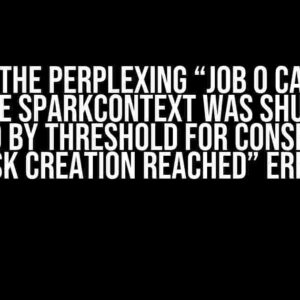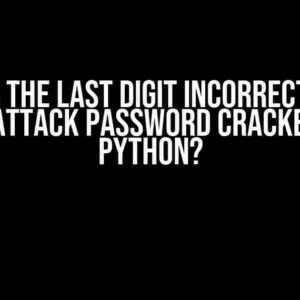Are you struggling to understand why the SHA-256 hash computed by CryptoJS is different from what you expected? You’re not alone! Many developers have encountered this issue, and it’s not because CryptoJS is faulty, but rather due to some crucial nuances in how the library handles hashing. In this article, we’ll delve into the reasons behind this discrepancy and provide you with clear instructions on how to get the correct hash value.
What is SHA-256 and Why is it Important?
SHA-256 (Secure Hash Algorithm 256) is a widely used cryptographic hash function that produces a 256-bit (32-byte) hash value from input data of any size. This one-way function is designed to be collision-resistant, meaning it’s computationally infeasible to find two different input strings with the same output hash.
SHA-256 is crucial in various cryptographic applications, such as:
- Data integrity: Hashing data to ensure its integrity and detect any tampering.
- Password storage: Storing passwords securely using salted and hashed values.
- Digital signatures: Creating digital signatures to verify the authenticity of messages.
The CryptoJS Library and SHA-256
CryptoJS is a popular JavaScript library for cryptographic functions, including SHA-256. It provides an easy-to-use interface for hashing data, but, as we’ll see, there are some gotchas to be aware of.
const CryptoJS = require('crypto-js');
const data = 'Hello, World!';
const hash = CryptoJS.SHA256(data);
console.log(hash.toString());This code snippet should give you a SHA-256 hash value, but is it the correct one?
The Problem: Character Encoding and Padding
The issue lies in how CryptoJS handles character encoding and padding. By default, CryptoJS assumes the input data is a string and encodes it as UTF-16 (a 16-bit Unicode encoding scheme). This can lead to different hash values depending on the encoding used.
To further complicate matters, CryptoJS pads the input data with null bytes (‘\x00’) to ensure the data length is a multiple of the block size (64 bytes for SHA-256). This padding can also affect the final hash value.
Solution 1: Using UTF-8 Encoding
const textEncoder = new TextEncoder('utf-8');
const data = 'Hello, World!';
const encodedData = textEncoder.encode(data);
const hash = CryptoJS.SHA256(encodedData);
console.log(hash.toString());Solution 2: Disabling Padding
const data = 'Hello, World!';
const hash = CryptoJS.SHA256(data, { 'padding': CryptoJS.pad.NoPadding });
console.log(hash.toString());Additional Considerations
Binary Data and Arrays
const binaryData = new Uint8Array([0x01, 0x02, 0x03, 0x04]);
const hash = CryptoJS.SHA256(binaryData);
console.log(hash.toString());Browser and Node.js Differences
Comparison with Other Libraries
- Different character encoding schemes (e.g., UTF-16 vs. UTF-8)
- Padding (or lack thereof)
- Implementation differences between libraries
Conclusion
In conclusion, the SHA-256 hash computed by CryptoJS can be different due to character encoding and padding nuances. By understanding these subtleties and using the solutions provided, you can ensure you get the correct hash value. Remember to consider additional factors like binary data, browser and Node.js differences, and comparisons with other libraries. With this knowledge, you’ll be well-equipped to tackle cryptographic hashing with confidence.
| Solution | Description |
|---|---|
| Using UTF-8 encoding | Explicitly encode input data as UTF-8 before hashing |
| Disabling padding | Disable padding using the `padding` option in CryptoJS |
Further Reading
If you’re interested in learning more about cryptographic hashing, character encoding, and padding, we recommend exploring the following resources:
- NIST’s SHA-256 specification: https://nvlpubs.nist.gov/nistpubs/FIPS/NIST.FIPS.180-4.pdf
- UTF-8 encoding: https://en.wikipedia.org/wiki/UTF-8
- CryptoJS documentation: https://crypto-js.googlecode.com/svn/tags/3.1.2/docs/
By mastering the intricacies of SHA-256 hashing with CryptoJS, you’ll be better equipped to tackle a wide range of cryptographic challenges in your projects.
Frequently Asked Question
Wondering why the SHA-256 hash computed by CryptoJS is different from what you expected? Don’t worry, we’ve got you covered! Check out these FAQs to resolve the mystery.
Why does the SHA-256 hash generated by CryptoJS differ from the one generated by other tools?
The culprit might be the encoding! CryptoJS uses UTF-8 encoding by default, whereas other tools might be using a different encoding. Make sure to specify the correct encoding when generating the hash. For example, you can use `CryptoJS.SHA256(“your_string”, { encoding: ‘latin1’ })` to get the hash in Latin-1 encoding.
I’m using the same encoding, but the hash is still different. What’s going on?
Ah-ha! It’s time to inspect the data! Double-check that you’re feeding the same input data to CryptoJS and the other tool. Even a single whitespace or newline character can alter the hash. Also, ensure that you’re not trimming or modifying the input data in any way.
I’ve verified the input data, but the hash is still different. Could it be a bug in CryptoJS?
Unlikely, but not impossible! CryptoJS is a well-tested and widely-used library. However, it’s possible that you’ve stumbled upon a rare edge case. Try updating to the latest version of CryptoJS or searching for similar issues on GitHub. If you’re still stuck, create a minimal reproducible example and share it with the community for help.
How do I troubleshoot the issue and find the root cause?
Time to get detective! Start by logging the input data and the generated hash at each step. Verify that the input data is what you expect, and the hash is being generated correctly. You can also try using a debugging tool or a code snippet to isolate the issue. If you’re still stuck, try breaking down the problem into smaller, more manageable parts and test each component individually.
What’s the best way to ensure the SHA-256 hash is correct and consistent across different tools?
Consistency is key! To ensure the hash is correct and consistent, use a standardized input format, such as hexadecimal or base64, and specify the encoding explicitly. Also, make sure to use the same hash algorithm (SHA-256, in this case) and avoid any intermediate conversions or transformations. Finally, test your implementation with a known input and verify the output against a trusted reference.



